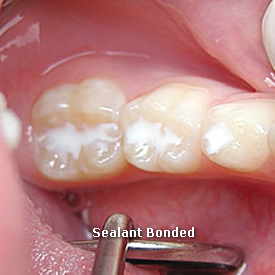Sealants
It is a fact that cavities start mainly in the grooves and pits on the biting surfaces of posterior teeth. Not only are these fine grooves inaccessible to the cleaning action of the toothbrush bristles but they also have a very thin layer of protective enamel making them more susceptible to decay.
A sealant is a clear or colored plastic material that flows into the grooves and depressions of the back teeth filling them in, rendering these areas resistant to tooth decay. Sealants are generally placed on children’s permanent back teeth because access to cleaning and regular oral hygiene can be problematic in this age group. They should be applied as soon as the first molars are fully erupted between six and seven years of age, as sealants are only effective on decay free teeth.
The lifespan of a sealant is generally three to five years although they can last longer. regular dental examinations are necessary to ensure they remain intact.
Sealants are easily placed and well tolerated by children, as they require no anesthetic. The procedure is as follows:
- The tooth surface is cleaned to remove plaque and debris.
- A gel is applied that allows the sealant to penetrate and adhere.
- Liquid sealant is allowed to flow into the grooves.
- A light is placed over the liquid sealant to harden it and allow it to set.
Sealants offer significant protection to the biting surfaces of teeth. However other areas around the gum line and between the teeth still remain vulnerable to tooth decay, and require the conventional methods of brushing and flossing to protect them. The use of sealants in conjunction with daily home care and regular check ups offer children the possibility of a cavity free life.



Hours
9am - 6pm
Closed
